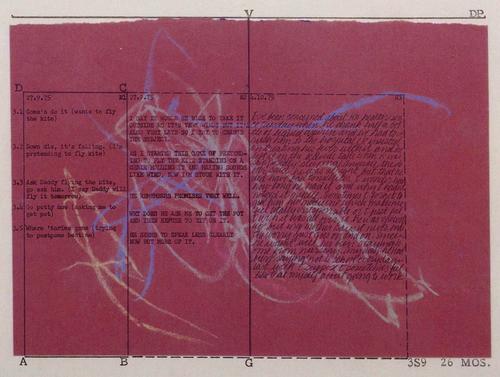Research Project A10. Evocation of reality as artistic process
Mary Kelly: Post Partum Document, "Documentation III (Analysed markings and diary-perspective schema), Detail ", Toronto, Collection Art Gallery of Ontario, 1975, 27,9 cm x 35,6 cm, Plexiglas, weißer Karton, Holz, Papier, Tinte, Gummi
Head
Research Associates
Christian Liclair / Dr. Renate Wöhrer
Student Assistants
Objective
The project investigates forms of evocation of reality in art primarily in the 1960s and 1970s. The focus will be on positions that firmly avoid recourse to artistic traditions of representation of reality, in other words that do not fall back on the persuasiveness of mimetic processes. Evocation of reality does not mean the attempt to ‘reproduce’ reality, but nor should reality be adopted as a ‘mere’ construct. Our interest is addressed, rather, to artistic works that locate evocation of reality at the procedural level and which, in laying bare this procedure, show it to be a process that is subject to factors of selection, interpretation, production, presentation, etc. and one that reflects conditions of mediatisation and generation. The disclosure of the procedure thereby serves as both the touchstone and the guarantee of the reference to reality, and in this functional ambivalence thus becomes central to the relationship of art to its exterior. The focus in terms of time on the 1960s and 1970s seems particularly fruitful insofar as the art of these years – in particular conceptual art – subjected the institution of Art, its categories and possibilities to a rigorous critical interrogation. This inevitably also required a renegotiation of the boundary between art and non-art and consequently raised questions regarding a specifically artistic treatment of reality, questions that continue to have an impact today. These are examined in the project by taking two areas as examples. The first subproject looks at the transfer into art of documentary processes, and thus processes striving towards ‘objective’ evidence, while the second subproject investigates the significance of the subjective experience of reality for feminist conceptual art.
Subproject 1: Document as paradigm. References to reality in 20th century art
(Prof. Karin Gludovatz and Renate Wöhrer, M.A.)
The subproject investigates documentarisms in the art of the modern and post-modern era with regard to their ability to evoke reality and to reflect the relationship between reality and representation. The primary focus is thereby directed towards the relationship, or more accurately the interdependency between documentary methods of representation on the one hand, and the respective definition of the documentary and the respective concept of the document on the other. The documentary is understood as a generic form which is not stable in its historical configuration and whose potential to evoke reality must be regularly redefined. The category of the document serves, within the changing course of time, as a reference value with regard to the definition of the relationship to reality. The subproject starts from two significant historical displacements. The first is the transfer into art of documentary pictorial forms and practices from spheres such as journalism and science, which took place in the 1960s. We thereby examine the accompanying reconfigurations and resignifications of methods of representation, categorizations and definitions of terms as well as the relationship between documentary and artistic aesthetics. On the basis of this, we then ask how documentary pictorial forms and procedures took shape in the first place. For this reason, our second focus falls upon the significance of those concepts and semantics of the document that were decisive for the formulation of a notion of the documentary in the 1920s and were carried over into visual forms of representation. It is the aim of this subproject to study these two transfer processes – previously largely ignored in the literature – from a historical perspective and in a systematic manner as key turning-points for the evolution of the documentary, and to establish their connections and significance with regard to the development of artistic documentarisms.
Subproject 2: ContraDicting Conceptualism. The search for subjective experience of reality in feminist conceptual art of the 1960s and 1970s
(Prof. Karin Gludovatz and Manuela Ammer, M.A.)
The second subproject investigates feminist positions of the 1960s and 1970s which devoted themselves, within the sphere of conceptual art, to the question of subjective experience of reality, and which thus made productive use of the contradictions between concept and expression that were constitutive for artistic practice but which were frequently passed over in the literature. It explores the hypothesis that, by focusing upon a paradigm associated with buzz words such as ‘dematerialisation’ and ‘objectifiability’ and which deemed the intellectual act and its verbalization to be the primary determining factors in a work’s formation, contemporary reception and consequently art-historical scholarship significantly underestimated the true radius of action of conceptual practices. In the example of artists such as Lee Lozano and Ree Morton, whose works have returned increasingly to the public eye in the last few years but who are missing from most overall surveys of conceptual art, we attempt to show that conceptual art, although it questioned the notion of art as personal expression and voiced criticism of certain notions of subject, did not avoid statements on expression and subjectivity as a matter of principle. Lozano and Morton worked on this problem insofar as they deliberately associated conceptual strategies with elements that run counter to a dogmatic concept of artistic conception. The very contradiction inherent in their exploration of categories of physicality and emotionality and in their insistence upon individual experience and social dimensions within an abstracted conceptual vocabulary, can point up the ideological preconditions and boundaries underpinning the prevailing reception of a subjectivity model of conceptual art.
